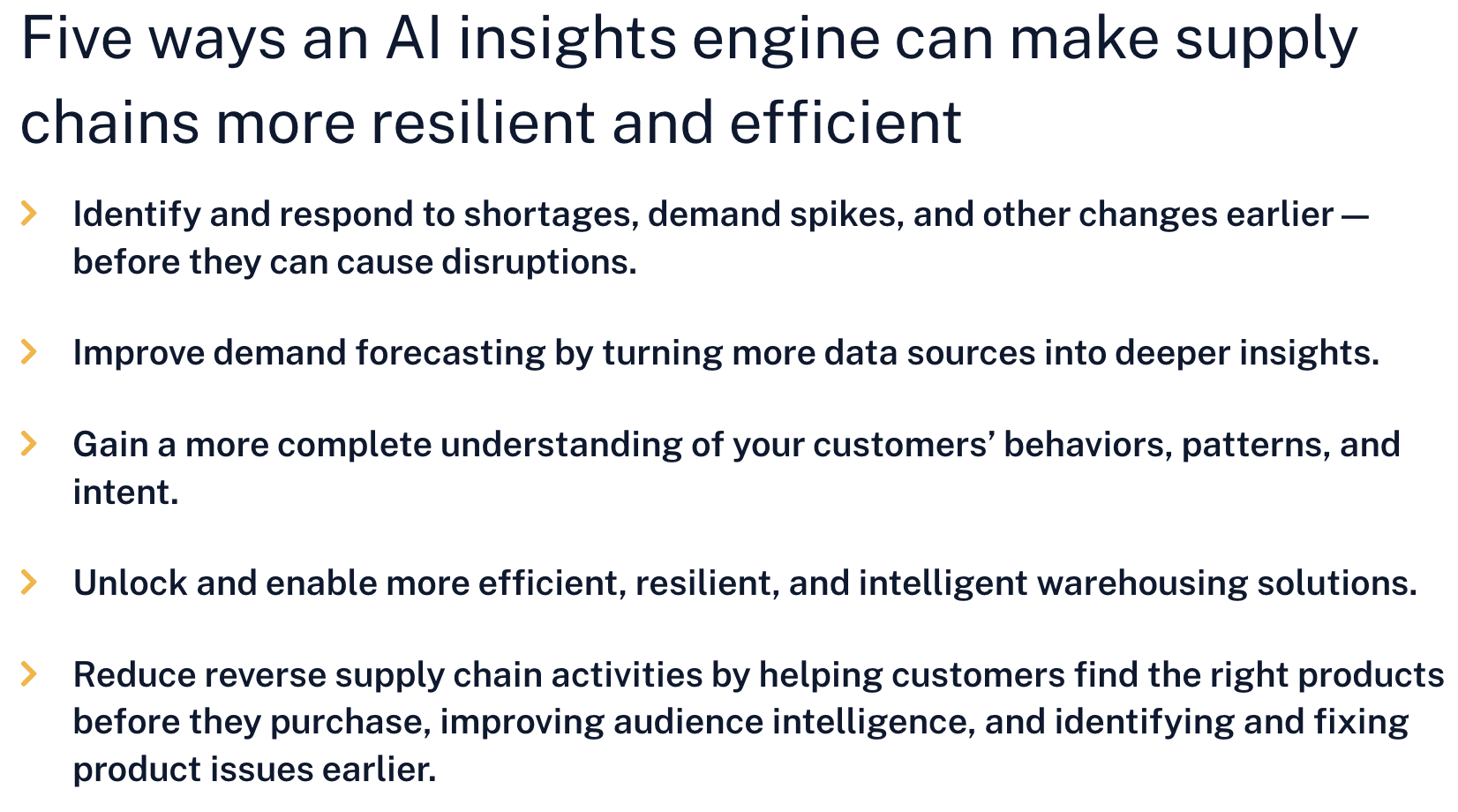Exploring the Connections Between Insight Engines and Supply Chains
How can an advanced, AI-powered insight engine make global supply chains more efficient and resilient?

Over the past few years, supply chain professionals have faced an unusual (to put it mildly) list of challenges—from the sudden, massive disruptions caused by the COVID-19 pandemic to shifting geopolitical dynamics and increasingly common extreme weather events. As a result, the professionals who build and manage supply chains have had no choice but to quickly adapt.
According to Mercado Labs CEO Robert Garrison in a recent Forbes article, “The supply chain industry survived 2022 by doing whatever it took to get the products to their customers… Importers were in complete survival mode, throwing money at problems just to ensure that their supply chains would keep moving and some vestige of products arrived on shelves for desperate consumers.”
Good times. But for those who enjoy silver linings, this challenging period did lead to the development of some important new strategies that have made supply chains more flexible and resilient. Since early 2020, organizations have diversified and expanded their supplier networks, built up larger inventory buffers, brought more products closer to customers through nearshoring and in-store or “dark store” warehousing, expanded the use of supply chain ecosystem partnerships, and more.
Efficiency vs. Resilience
How do you make supply chains more resilient without making them less efficient?
These strategies have made a positive impact. There are certainly far fewer front-page stories about supply chain disruptions and product shortages today than there were two years ago. Suppliers and retailers are clearly better equipped to deal with global disruptions and uncertainty. But these hard-won improvements have also come at a cost. In many cases, improving supply chain resilience has also meant sacrificing supply chain efficiency. For example, Lean or Just-in-Time manufacturing and inventory management practices are very efficient, but they are also highly vulnerable to supply chain disruptions. Building up larger inventory buffers in more locations, on the other hand, creates more resilience, but it can also be more expensive and less efficient.
So if resilient supply chains are so important in today’s increasingly uncertain, unpredictable world (and they definitely are), how can organizations offset these costs? What will it take to transform the concept of supply chain resilience from a purely defensive form of protection against inevitable future disruptions—into a business advantage that can also help increase sales and grow profits?
The supply chain industry survived 2022 by doing whatever it took to get the products to their customers.
–Robert Garrison, CEO, Mercado Labs
Some of the most intriguing and promising answers to these “resilience vs. efficiency” questions revolve around a new generation of advanced AI-powered insight engines. With the right approach, these tools have the potential to make complex supply chains more intelligent and responsive. This will help unlock new improvements in both efficiency and resilience. By injecting AI-powered insights directly into supply chains, organizations can gather and analyze massive amounts of data from different sources to predict demand, improve forecasting, streamline logistics and fulfillment, and more. Here are a few specific examples of how integrating AI insights can strengthen and enhance activities across complex supply chain umbrellas:
1. Detect and act on demand trends and supply chain shifts earlier
AI has made it possible for search platforms to go far beyond simply returning results based on basic text queries. Today, companies can collect, combine, and analyze massive amounts of internal and external data from a growing number of sources to understand and provide recommendations based on their customers’ habits, behaviors, and intent.
Organizations can use similar technology to identify complex supply chain demand trends earlier, predict shifts in demand more accurately, and make intelligent adjustments to avoid shortages. For example, what if a food supplier could monitor and analyze data from millions of social media posts to identify recipes that go viral in specific regions, accurately predict localized demand spikes for certain ingredients, and proactively increase or move supplies of the needed raw materials to avoid disruptions and delays? That data certainly already exists and is readily available. But they would need an advanced, AI-powered natural language processing and data analysis engine to collect and convert it all into early, actionable insights. That’s exactly what an AI insights engine—adapted for use inside a supply chain—can provide.
2. Enable more versatile and efficient warehousing solutions
To make their supply chains more resilient and efficient, many organizations have been exploring new inventory and warehousing models—from moving to more flexible, on-demand third-party logistics (3pl) warehousing solutions to converting traditional retail spaces into “dark stores” and other types of hyper-local mini-warehouses.
These changes make it possible to move in-demand products and supplies closer to the customers who need them. This can lower shipping costs and eliminate travel-related disruptions. But of course, unraveling and managing the intricacies of these highly de-centralized warehousing options requires a powerful, intelligent technology engine that can analyze massive amounts of data to understand and correctly predict demand, know where products should be stored in relation to the customers who need them, and calculate the fastest, cheapest way to get goods from a dispersed, decentralized network of small warehouses to their final destinations.
Some of the largest retail and logistics organizations have built their own AI-powered engines to manage and optimize these incredibly complex dynamics. But for most organizations, it makes sense to use an existing, pre-built platform that’s designed to gather and analyze the massive amounts of data needed to make decentralized warehousing models work.
3. Streamline (and shrink) reverse supply chain activities
Nearly every business that depends on an efficient and resilient supply chain needs an equally effective reverse supply chain—which refers to all the activities and processes required to move goods from customers back to sellers or manufacturers. This includes everything from basic product returns to proactively collecting, remanufacturing, and re-selling used or worn-out products. For many businesses, building and managing reverse supply chains can turn into a costly drain on resources.
This is another area where an AI insights engine can not only make reverse supply chains more efficient—but also reduce the size and scope of those activities. For example, before goods are shipped to customers, an AI engine can leverage computer vision technologies to automatically monitor production floors, perform quality inspections, and identify defective products before they ship. Similar visual AI technologies can also scan and analyze images of returned items to automate the return authorization process.
But it’s important to understand that the potential impact of AI within reverse supply chains goes beyond factory or warehouse floor activities. With today’s advanced AI-powered search technologies, businesses can also minimize returns by helping customers find the best products for their needs and learn more about those products before they buy—through visual searching; virtual and augmented reality; intelligent, intent-based recommendations; and other advanced AI-powered capabilities.

A capable AI insights engine also allows organizations to comb through online reviews and forums to collect and analyze data about specific products and they people who purchase them. This enhanced audience intelligence makes it possible to understand how products or services are being used in the real world; accurately measure overall product sentiment; and quickly identify, prioritize, and correct product or supply issues. These deeper insights will ultimately lower return rates and reduce the strain on reverse supply chains—and increase customer satisfaction in the process.
Start integrating advanced search into your supply chain
It’s clear that an advanced AI insights engine, when it’s implemented and integrated correctly, can play a central role in making modern supply chains and reverse supply chains more resilient and efficient—even in the face of growing uncertainty and increasing disruptions. But where should you start? What types of AI-powered solutions make the most sense for your business? And what’s the most practical, efficient way to bring AI insights into your supply chain infrastructure?
Fortunately, Lucidworks is already working with organizations to put our advanced AI insights platform to work inside global supply chains. We’re ready to partner with you to propose and deliver proven solutions that use computer vision, large language models, predictive analytics and forecasting, intent-based results, and other AI technologies to make your supply chain (and reverse supply chain) more efficient, resilient, and future proof.
Best of the Month. Straight to Your Inbox!
Dive into the best content with our monthly Roundup Newsletter!
Each month, we handpick the top stories, insights, and updates to keep you in the know.